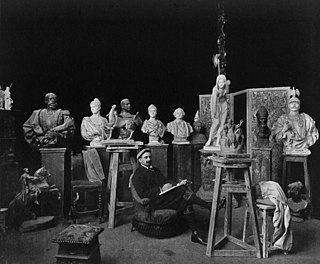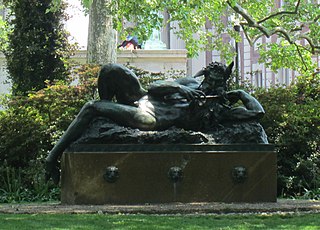
Karl Theodore Francis Bitter was an Austrian-born American sculptor best known for his architectural sculpture, memorials and residential work.

The Back Bay Fens, often called The Fens, is a parkland and urban wild in Boston, Massachusetts, in the United States. It was established in 1879. Designed by Frederick Law Olmsted to serve as a link in the Emerald Necklace park system, the Fens gives its name to the Fenway-Kenmore neighborhood.

Madison Square is a public square formed by the intersection of Fifth Avenue and Broadway at 23rd Street in the New York City borough of Manhattan. The square was named for James Madison, fourth President of the United States. The focus of the square is Madison Square Park, a 6.2-acre (2.5-hectare) public park, which is bounded on the east by Madison Avenue ; on the south by 23rd Street; on the north by 26th Street; and on the west by Fifth Avenue and Broadway as they cross.

The Conservatory Garden is a formal garden near the northeastern corner of Central Park in Upper Manhattan, New York City. Comprising 6 acres (24,000 m2), it is the only formal garden in Central Park. Conservatory Garden takes its name from a conservatory that stood on the site from 1898 to 1935. It is located just west of Fifth Avenue, opposite 104th to 106th Streets.

Rosenborg Castle Gardens is the oldest and most visited park in central Copenhagen, Denmark. Established in the early 17th century as the private gardens of King Christian IV's Rosenborg Castle, the park also contains several other historical buildings, including Rosenborg Barracks, home to the Royal Guards, as well as a high number of statues and monuments. The park also holds art exhibitions and other events such as concerts in the summer.

Conservatory Water is a pond located in a natural hollow within Central Park in Manhattan, New York City. It is located west of Fifth Avenue, centered opposite East 74th Street. The pond is surrounded by several landscaped hills, including Pilgrim Hill dotted by groves of Yoshino cherry trees and Pug Hill, resulting in a somewhat manicured park landscape, planned in deferential reference to the estate plantings of the owners of the mansions that once lined the adjacent stretch of Fifth Avenue.

The Bartholdi Fountain is a monumental public fountain, designed by Frédéric Auguste Bartholdi, who later created the Statue of Liberty. The fountain was originally made for the 1876 Centennial Exposition in Philadelphia, Pennsylvania, and is now located at the corner of Independence Avenue and First Street, SW, in the United States Botanic Garden, on the grounds of the United States Capitol, in Washington D.C.

Boy with Goose, is a public artwork by Italian artist Girolamo Piccoli, currently in storage in Milwaukee, Wisconsin, United States.

Untermyer Park and Gardens is a historic 43-acre (17 ha) city public park, located in Yonkers, New York in Westchester County, just north of New York City. The park is a remnant of Samuel Untermyer's 150-acre (61 ha) estate "Greystone". Situated on the steep land arising from the eastern bank of the Hudson River to the bluff on top of it, the park features a Walled Garden inspired by ancient Indo-Persian gardens, a small Grecian-style open-air amphitheater with two facing sphynxes supported by tall Ionic columns, a classical pavilion, stoa and loggias, a rock-and-water feature called "The Temple of Love", as well as a long staircase from the Walled Garden to an Overlook with views of the river and the Palisades.

The LuEsther T. Mertz Library is located at the New York Botanical Garden (NYBG) in the Bronx, New York City. Founded in 1899 and renamed in the 1990s for LuEsther Mertz, it is the United States' largest botanical research library, and the first library whose collection focused exclusively on botany.

Frances Hodgson Burnett Memorial Fountain, located near Fifth Avenue and the Museum of the City of New York in Manhattan's Central Park, is an outdoor bronze sculpture and fountain which serves as a memorial to Burnett, the author of several literary classics including The Secret Garden and Little Lord Fauntleroy.

Walter Schott was a German sculptor and art professor.

The Great God Pan is a bronze sculpture by American sculptor George Grey Barnard. Since 1907, it has been a fixture of the Columbia University campus in Manhattan, New York City.

William Tecumseh Sherman, also known as the Sherman Memorial or Sherman Monument, is a sculpture group honoring William Tecumseh Sherman, created by Augustus Saint-Gaudens and located at Grand Army Plaza in Manhattan, New York. Cast in 1902 and dedicated on May 30, 1903, the gilded-bronze monument consists of an equestrian statue of Sherman and an accompanying statue, Victory, an allegorical female figure of the Greek goddess Nike. The statues are set on a Stony Creek granite pedestal designed by the architect Charles Follen McKim.

Pulitzer Fountain is an outdoor fountain located in Manhattan's Grand Army Plaza in New York. The fountain is named after newspaper publisher Joseph Pulitzer who died in 1911 having bequeathed $50,000 for the creation of the fountain. Pulitzer intended his fountain to be "like those in the Place de la Concorde, Paris, France." The fountain was designed by the architect Thomas Hastings, and crowned by a statue conceived by the sculptor Karl Bitter. The fountain was dedicated in May 1916.

Aktien-Gesellschaft Gladenbeck was a foundry located in Berlin, Germany, that operated from 1851 until 1926. During the 75-year period when the foundry was in operation it was one of the most important foundries in Germany and was known for producing high quality bronze castings.

Three Dancing Maidens is a nymph fountain (Nymphenbrunnen) sculpture by Walter Schott. There are three full-size versions or castings of the bronze sculpture: One known as the Untermyer Fountain in Central Park, New York, the second one in Antwerp’s Den Brandt Park, and the third one in the courtyard of the Burg Schlitz castle, a grand hotel in the Mecklenburg region of northern Germany. Identification of the original sculpture created for Rudolf Mosse in 1909, and later looted by the Nazi Party is the subject of research, which appears to be leading to the version in the Burg Schlitz castle. Three-quarters scale castings, likely to be examples of the sculptor's early drafts, can be found in Germany, Austria, and Northern California.



















